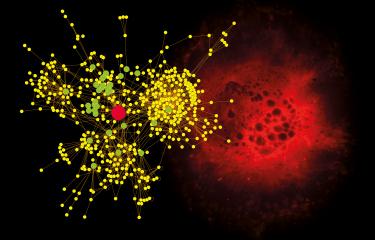Research teams from INSERM and the Institut Pasteur have just discovered the virulence mechanism of the Rift Valley Fever virus. This virus, often fatal in humans, regularly decimates herds of livestock in Africa.
Understanding the interactions between the host and this virus should make it possible to identify new therapeutic targets against Rift Valley Fever.
This research, published in the journal Cell on 20 February 2004, also emphasizes the importance of the candidate vaccine currently in development by Institut Pasteur researchers.
Press release
Paris, febuary 20, 2004
An Emerging Disease
The Rift Valley Fever virus is largely transmitted by mosquitoes. In Africa, it is responsible for vast epidemics in animals (epizootics) and in humans. In Kenya and Somalia in 1997-8, it claimed about 500 human victims and killed tens of thousands of heads of livestock.
The disease is considered to be emerging since it spread beyond Africa in 2000, affecting 863 individuals in Saudi Arabia (120 deaths), and more than a thousand individuals in Yemen (121 deaths).
The Rift Valley Fever virus is a potential agent of bioterrorism: it is listed under the American NIH and CDC’s category ’A’ alongside plague and anthrax. In humans, the infection can lead to severe encephalitis and to liver illnesses with serious and often fatal hemorrhagic fevers.
This virus can linger in nature for several years in infected insect eggs and might reappear during rainstorms, when the eggs hatch.
The teams of Jean-Marc Egly (INSERM Unit 596 ’Molecular Biology and Genetic Engineering’ - IGBMC, Strasbourg) and Michèle Bouloy (Molecular Genetics of Bunyaviridae Unit, Institut Pasteur, Paris) have deciphered the virus’s mechanism of action. They demonstrate how a viral protein named ’NSs’ blocks the host’s cellular machinery. The NSs protein is found in a filamentous shape in the nucleus of the infected cell.
It is also within the nucleus that the ’TFIIH transcription factor’, a multi-subunit element essential to the cell’s life because it is involved in protein production, is produced. The filamentous protein literally captures one of the subunit of TFIIH, thus putting this vital factor ’out of service’.
The researchers have thus precisely identified the target of the virus. This should make it possible in future to develop specific therapies against infection by the Rift Valley Fever virus.
Research Marking a Double Advance
This collaboration demonstrates that the research falls within a continuum. In fact, the study of the mechanisms of gene regulation has made it possible to apply molecular biology to virology.
The researchers also point out the importance of pursuing research on the TFIIH transcription factor, beside its specific involvement in Rift Valley Fever, because it will supply basic information about the intervention of this factor in several mechanisms involved in gene expression.
Finally, these results encourage the Institut Pasteur researchers that they are on the trail of a good candidate vaccine. In the past few years, they have put together a genetically attenuated vaccine, in which the gene coding for the NSs protein of the virus-which, as we have seen, is directly responsible for the virulence-was suppressed.
Tested successfully in mice, this candidate vaccine has also shown its harmlessness to sheep in experiments conducted in collaboration with the Food and Agriculture Organisation (FAO) and the Senegalese Institute of Animal Husbandry. Continuing studies are aimed at initially developing a veterinary vaccine. But this candidate vaccine could also be useful for immunizing people who have contact with livestock.
Sources
"TFIIH Transcription factor, a target for the Rift Valley Hemorrhagic Fever Virus" Cell, vol. 116, pp. 1-20, 20 February 2004
Nicolas Le May (1), Sandy Dubaele (2), Luca Proietti De Santis (2), Agnès Billecocq (1), Michèle Bouloy (1), Jean-Marc Egly (2)
(1) Molecular Genetics of Bunyaviridae Unit, Institut Pasteur, Paris
(2) Genetics and Molecular Biology Institute - INSERM Unit 596 ’Molecular Biology and Genetic Engineering’, Strasbourg
Contact press
Institut Pasteur
Nadine Peyrolo
01 44 38 91 30 - npeyrolo@pasteur.fr
Corinne Jamma
01 40 61 33 41 - cjamma@pasteur.fr
Inserm
Séverine Ciancia
01 44 23 60 86 - ciancia@tolbiac.inserm.fr
Chercheur
Jean-Marc Egly
03 88 65 34 47 - egly@igbmc.u-strabg.fr



